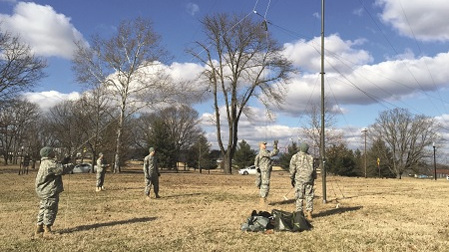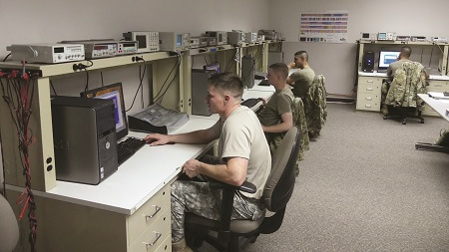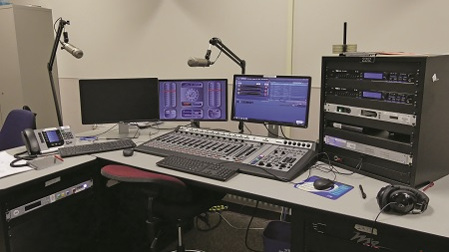Is Your Future Engineer Wearing Cammies?
ALEXANDRIA, VA.—Over the course of its history, the United States military has been responsible for innovations that have found their way into civilian life.

Students of the Defense Information School’s Broadcast Radio and TV Systems Maintenance Course raise an antenna during a field exercise at Ft. Meade, Md.
Those innovations require much technical training. In the case of broadcast engineers and technicians, a soldier, sailor, airman or Marine who performs that duty gets training that makes them valuable once they hang the uniform up for good. Former military people make good employees because they have demonstrated discipline, ability to solve problems, attention to detail and flexibility. To survive and thrive in a radio station environment, one needs all of those traits.
For military engineers in broadcast, training begins at the Defense Information School at Ft. Meade, Md. There, soldiers, sailors, airmen and Marines assigned to American Forces Radio and Television networks and outlets hone their professional skills in a 71-day resident course involving IT, audio, video and RF called the Broadcast Radio and Television System Maintenance Course.
The course builds knowledge and skills necessary to support multimedia production and broadcast missions of the Department of Defense and the Defense Media Activity. Graduates must demonstrate proficiency in operating and maintaining transmission systems, constructing and maintaining a multimedia local area network, installing software, and maintaining radio studios and a satellite downlink system.

Students at individual instruction carrels.
DINFOS also teaches a basic television equipment maintenance course for Army soldiers. Don’t let the name fool you. The 124-day course teaches fundamentals of electronics, instruction and training on direct and alternating current principles, solid-state fundamentals, including transistor amplifier theory, digital principles and basic soldering techniques. Students then apply these basic electronic concepts to the maintenance and repair of broadcast television and radio equipment.
The professional video industry's #1 source for news, trends and product and tech information. Sign up below.
To pass the course, the graduate must be able to use audiovisual equipment to monitor, troubleshoot and repair computers, television cameras, videotape recorders, audio systems, broadcast studios, automated audio and visual equipment, as well as transmission systems. Additionally, graduates will be able to set-up and maintain video teleconferencing systems. This course is designed for entry-level service members.
Those courses are taught by the DINFOS broadcast operations and maintenance department. Instructors are active duty military and civilian people.
Jonathan Ehrhart is a civilian instructor who also taught in the BOMD while on active duty in the Army and was a maintainer himself.

Students deploying a satellite downlink at the Defense Information School’s field training site at Ft. Meade, Md.
“As I’ve explained when asked what is it you [maintenance people] actually do, is that all the stuff that you use to do your job, we fix it. We make sure you can do your job.”
Ehrhart says the courses don’t just rely on classroom work. All of the skills learned are tested in a field training exercise where equipment is deployed under field conditions.
“We’re going to set this equipment up from scratch, operate it, and if need be, troubleshoot it.”
Graduates get to work on equipment they will find at AFRTS networks such as IP-based consoles. They get a heavy dose of RF theory and hands on practice.
“We start at the very basics of electromagnetic spectrum and what an RF wave is, and how you create one.”
That includes AM, FM, TV, satellite and microwave propagation with hands on transmitter experience.
Ehrhart says there’s another reason why the courses have so much hands on experience. “One of the keys to being a maintainer is, if you don’t know how it works, you don’t know how to fix it. Because how do you know if it’s broken or functioning properly?”
Graduates of these courses are eligible to be certified by the Society of Broadcast Engineers at the Certified Broadcast Technologist (CBT) level and can receive 15 college credits at the associate and baccalaureate undergraduate level.
Ehrhart keeps in touch with former military maintainers. He says their job outlook, while OK, could be better.

One of the radio studios at the Defense Information School. They’re the same as those found at American Forces Radio and TV networks around the world.
“Our students have the benefit of having a variety of skills; that makes them valuable to any organization, not just a radio station or television station.”
He says some of his fellow graduates have encountered managers who did not want to hire engineers and maintainers full time.
“They don’t want to hire us full time and pay us because [the equipment] is working, why am I paying you? It’s a Catch-22. Your equipment is working because you have maintainers that keep it working.”
A good resource for stations looking to hire veterans is the Army’s Soldier For Life transition program, which has a web page for employment questions and opportunities: https://soldierforlife.army.mil/employment.
Paul Kaminski, CBT, has been a Radio World contributor and columnist since 1997. He’s retired from the United States Army; a 1971 graduate of the Defense Information School and an AFRTS Alumnus (Armed Forces Desert Network). Follow him on Twitter @msrpk_com or on Facebook at PKaminski2468.
This story first appeared on TVT's sister publication Radio World.
